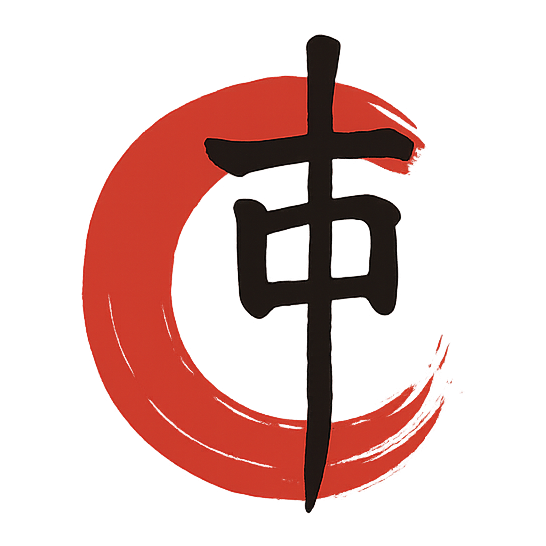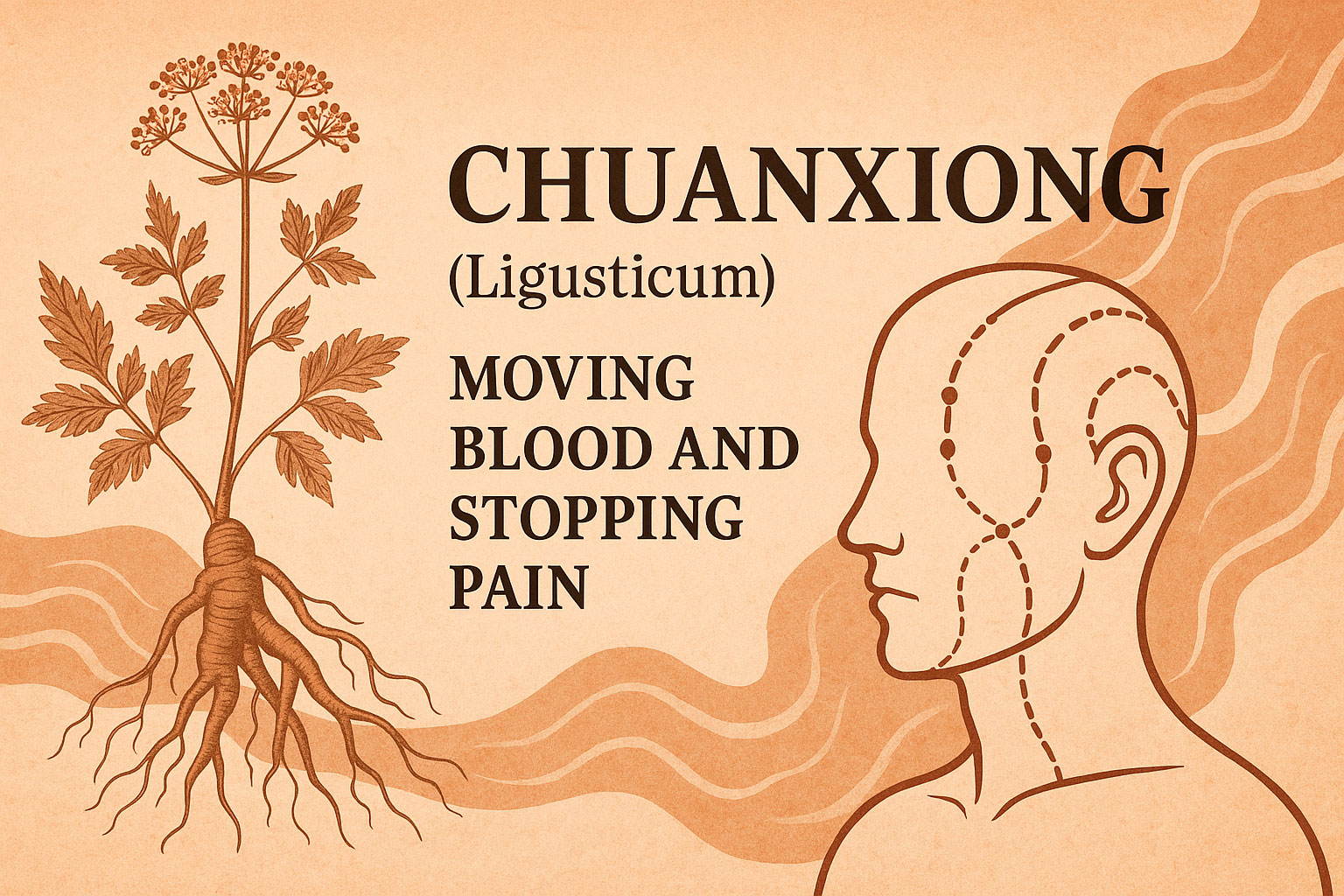Chuanxiong (川芎) is a classic herb in Traditional Chinese Medicine (TCM), known for its ability to invigorate Blood, move Qi, and relieve pain. It is widely used in formulas for headaches, menstrual disorders, traumatic injuries, and any condition involving Qi and Blood stagnation.
With a warm and aromatic nature, Chuanxiong plays a bridging role between Blood and Qi regulation, making it a favorite among TCM practitioners for treating pain with underlying stagnation.
🔶 Botanical Profile
- Chinese name: 川芎 (Chuān Xiōng)
- Latin name: Ligusticum chuanxiong Hort.
- Part used: Rhizome
- Flavor and Nature: Acrid, warm
- Meridians entered: Liver, Gallbladder, Pericardium
🔶 Traditional Functions in TCM
| Function | Clinical Indication |
|---|---|
| Invigorates Blood and promotes Qi circulation | For Blood stasis syndromes: sharp pain, irregular menses, post-injury pain |
| Expels Wind and alleviates pain | Especially effective for headaches, dizziness due to Wind or Blood stagnation |
| Guides upward to the head | One of the few Blood-moving herbs that ascends, used for head-related symptoms |
🔸 It is especially valuable in gynecological and neurological conditions with underlying stasis or Cold.
🔶 Common Formulas with Chuanxiong
| Formula | Primary Use |
|---|---|
| Si Wu Tang (Four Substances Decoction) | Core formula for nourishing and moving Blood |
| Xiao Yao San (Free and Easy Wanderer) | For Liver Qi stagnation and emotional imbalance |
| Chuanxiong Cha Tiao San | Classic headache formula, especially for Wind-Cold type |
| Sheng Hua Tang | Postpartum Blood stasis and pain |
| Ge Xia Zhu Yu Tang | For Blood stasis in the abdomen and pelvic pain |
In most cases, Chuanxiong is paired with Blood tonics or Qi movers to enhance circulation without causing dryness or excess movement.
🔶 Modern Research Insights
Modern studies have identified several key active compounds, including:
- Ligustilide – analgesic, anti-inflammatory, neuroprotective
- Ferulic acid – antioxidant, promotes microcirculation
- Volatile oils – vasodilating effects
📌 Research-backed benefits:
- Relieves vascular headaches and migraines
- Improves cerebral blood flow
- Supports recovery in traumatic injuries
- Reduces inflammation in musculoskeletal disorders
Chuanxiong is also being studied for its protective effects on the nervous system and cardiovascular health.
🔶 Usage & Dosage
- Typical dosage: 3–10 grams in decoction
- Preparation: Often combined with Dang Gui, Bai Shao, or Xiang Fu
- Can be used in powders, pills, or topical formulas for injury and pain
🔶 Cautions
- Avoid during pregnancy, especially in early stages, due to strong Blood-moving action
- Use with care in patients with Yin deficiency and Heat signs
- May cause mild dizziness or dryness in sensitive individuals
🔶 Conclusion
Chuanxiong is a powerful herb that exemplifies the dynamic flow of Qi and Blood in TCM. Whether relieving a dull menstrual cramp or a splitting tension headache, it works by restoring circulation and breaking stagnation — two principles at the heart of pain relief in Chinese medicine. When used with precision and insight, Chuanxiong brings movement where there is blockage, and balance where there is stagnation.Chuanxiong (川芎) is a classic herb in Traditional Chinese Medicine (TCM), known for its ability to invigorate Blood, move Qi, and relieve pain. It is widely used in formulas for headaches, menstrual disorders, traumatic injuries, and any condition involving Qi and Blood stagnation.
With a warm and aromatic nature, Chuanxiong plays a bridging role between Blood and Qi regulation, making it a favorite among TCM practitioners for treating pain with underlying stagnation.
🔶 Botanical Profile
- Chinese name: 川芎 (Chuān Xiōng)
- Latin name: Ligusticum chuanxiong Hort.
- Part used: Rhizome
- Flavor and Nature: Acrid, warm
- Meridians entered: Liver, Gallbladder, Pericardium
🔶 Traditional Functions in TCM
| Function | Clinical Indication |
|---|---|
| Invigorates Blood and promotes Qi circulation | For Blood stasis syndromes: sharp pain, irregular menses, post-injury pain |
| Expels Wind and alleviates pain | Especially effective for headaches, dizziness due to Wind or Blood stagnation |
| Guides upward to the head | One of the few Blood-moving herbs that ascends, used for head-related symptoms |
🔸 It is especially valuable in gynecological and neurological conditions with underlying stasis or Cold.
🔶 Common Formulas with Chuanxiong
| Formula | Primary Use |
|---|---|
| Si Wu Tang (Four Substances Decoction) | Core formula for nourishing and moving Blood |
| Xiao Yao San (Free and Easy Wanderer) | For Liver Qi stagnation and emotional imbalance |
| Chuanxiong Cha Tiao San | Classic headache formula, especially for Wind-Cold type |
| Sheng Hua Tang | Postpartum Blood stasis and pain |
| Ge Xia Zhu Yu Tang | For Blood stasis in the abdomen and pelvic pain |
In most cases, Chuanxiong is paired with Blood tonics or Qi movers to enhance circulation without causing dryness or excess movement.
🔶 Modern Research Insights
Modern studies have identified several key active compounds, including:
- Ligustilide – analgesic, anti-inflammatory, neuroprotective
- Ferulic acid – antioxidant, promotes microcirculation
- Volatile oils – vasodilating effects
📌 Research-backed benefits:
- Relieves vascular headaches and migraines
- Improves cerebral blood flow
- Supports recovery in traumatic injuries
- Reduces inflammation in musculoskeletal disorders
Chuanxiong is also being studied for its protective effects on the nervous system and cardiovascular health.
🔶 Usage & Dosage
- Typical dosage: 3–10 grams in decoction
- Preparation: Often combined with Dang Gui, Bai Shao, or Xiang Fu
- Can be used in powders, pills, or topical formulas for injury and pain
🔶 Cautions
- Avoid during pregnancy, especially in early stages, due to strong Blood-moving action
- Use with care in patients with Yin deficiency and Heat signs
- May cause mild dizziness or dryness in sensitive individuals
🔶 Conclusion
Chuanxiong is a powerful herb that exemplifies the dynamic flow of Qi and Blood in TCM. Whether relieving a dull menstrual cramp or a splitting tension headache, it works by restoring circulation and breaking stagnation — two principles at the heart of pain relief in Chinese medicine. When used with precision and insight, Chuanxiong brings movement where there is blockage, and balance where there is stagnation.


发表回复